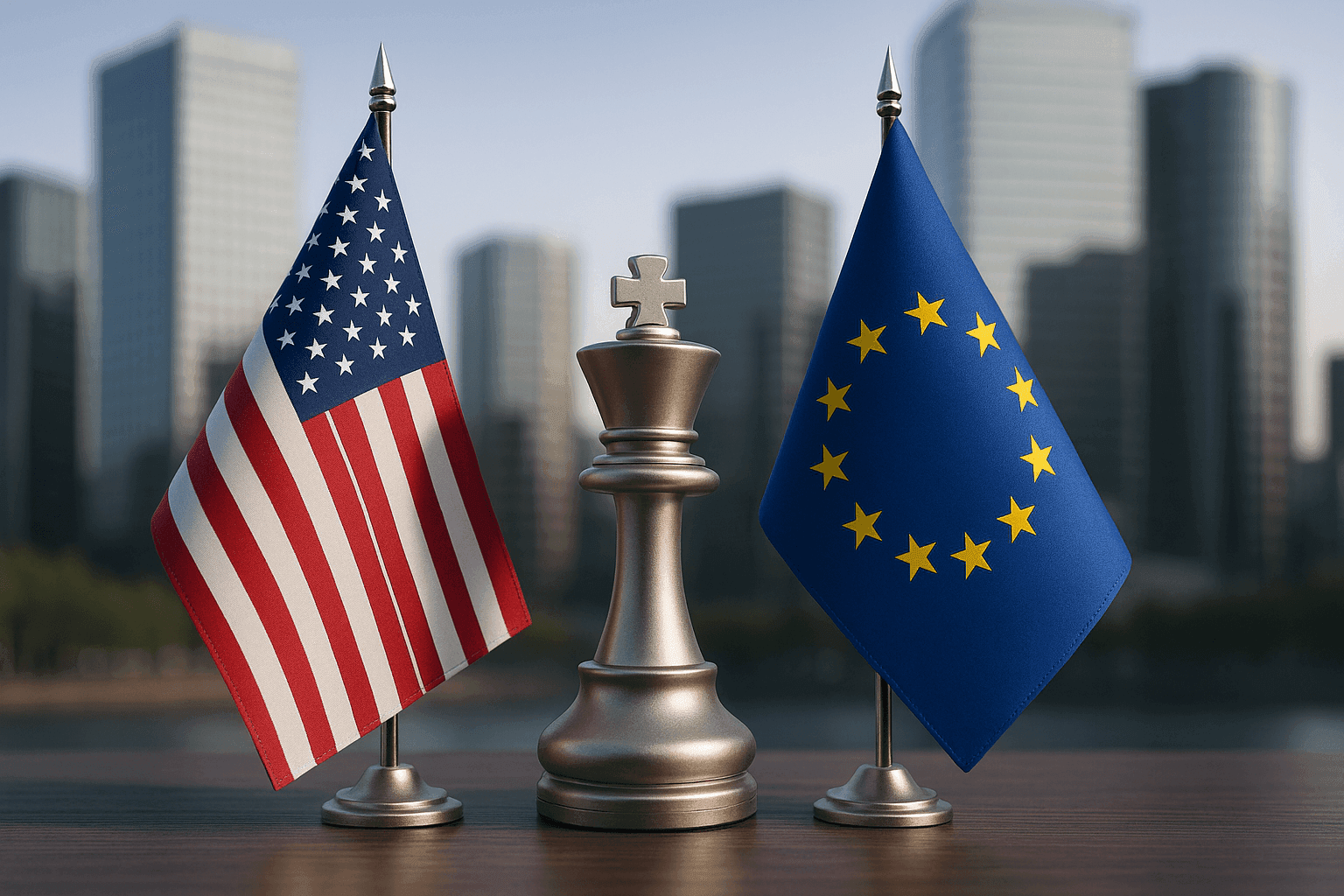Transatlantic Trade Deal 2025: What It Means for Private Equity, M&A, and Industrial Strategy
With massive EU capital flowing into US markets, the deal reshapes deal pipelines, sector priorities, and cross-border dynamics. For private equity investors, it is a rare moment to reposition strategically and fast.
- Home /
- EU-US Tariff Deal: What Companies Need to Prepare for Starting Today /
- Private Equity: Capital in Motion, Strategy in Demand
From Policy Shock to Portfolio Strategy
On Sunday, 27 July 2025, the European Union and the United States reached what is already being described as a landmark agreement. This transatlantic trade deal averted a looming tariff war and introduced a wide-ranging investment framework. A central component is the EU’s commitment to invest over USD 600 billion into American assets, targeting sectors such as energy, defence, and advanced technology.
As a consultant working closely with industrial and private equity clients, particularly in the industrial goods sector, I believe this agreement marks a turning point. It reshapes geopolitical risk, yes, but more importantly, it injects new momentum into cross-border transactions, transatlantic partnerships, and sector-specific investment strategies. Below is my strategic take on what this deal could mean for M&A activity, private equity investment, and innovation-driven growth in the years ahead.
1. A New Pipeline of Investment Targets
Most immediately, this deal releases an unprecedented flow of EU capital into US markets. The USD 600 billion pledge is not an abstract headline; it is a directive for rapid capital deployment into strategically important sectors. For private equity firms with transatlantic ambitions, this means a dramatically expanded pool of targets.
We anticipate rising deal activity across energy infrastructure, AI-enabled logistics, advanced defence systems, and dual-use industrial technologies. European funds can be a catalyst for European companies seeking acquisition targets and strategic partnerships in the US, especially those aligned with EU industrial policy and resilience goals.
This shift changes how EU investors view the US. It becomes not just a growth market, but a strategic imperative. With more capital, reduced regulatory hurdles, and political goodwill, transatlantic investment strategies gain a renewed sense of urgency.
2. A Dual Advantage for Infrastructure and Defence-Focused Funds
Private equity funds operating in infrastructure or defence-related sectors stand to benefit disproportionately. Their existing focus overlaps directly with the policy priorities of the agreement, placing them at the front of the queue for public-private co-investment and institutional capital backing.
For these investment areas, the opportunity is twofold: first, they can access fresh EU capital earmarked for sectors where they already hold expertise; and second, they enjoy enhanced access to the US market, where regulatory barriers are being eased for trusted European investors.
We expect to see a wave of cross-border co-investment platforms, binational infrastructure vehicles, and public-private alliances emerge. Firms able to mobilise capital quickly and navigate the complex geopolitics of defence and critical infrastructure will hold a strong first-mover advantage.
3. Implications for Portfolio Companies from Private Equity especially with high export volume like Industrial Goods
As a partner at H&Z with deep industry experience, I see direct implications for the Industrial Goods sector, which often operates below the radar of macroeconomic analysis but is in the heart of especially German economy.
First, there will be more opportunities for international growth, whether through acquiring US suppliers, expanding the value chain, or even US customers forming aftersales joint ventures or launching engineering centres closer to American clients. The reduction in trade frictions and the potential for regulatory convergence should make these moves more attractive.
Second, the capital shift could create competitive stress within Europe. If vast EU resources are directed to foreign acquisitions and energy imports, less may be available for domestic modernisation. European manufacturers must act now to ensure they are not outpaced in the next investment cycle.
We encourage Private Equity to respond with strategic clarity and calculated boldness by developing US expansion plans, securing supply chain alliances, and doubling down on automation and digital capability for their portfolio companies. The window for transatlantic industrial alignment is open but will not remain so indefinitely.
4. European Valuations Set to Rise Amid Competitive Tension
Not all the consequences of this deal will play out in the United States. One of the subtler dynamics is the likely rise in valuations for European industrial assets, particularly in sectors such as advanced manufacturing, automotive components, and engineering services.
As US investors become more confident in European political and regulatory stability, they are likely to enter European deal processes more assertively. This will increase competitive pressure for high-quality mid-market assets, driving up multiples and shortening deal timelines.
For sellers and private equity owners of industrial firms, this is clearly good news. However, for European buyout funds, the increased competition means value creation models must be sharpened. American capital is not just a buyer; it is a competitor with deeper pockets and increasingly global reach.
Final Thoughts: From Political Agreement to Industrial Strategy
This trade agreement is more than a policy reset; it is a strategic reorientation of transatlantic economic cooperation. For private equity investors, corporate boards, and innovation leaders, it creates a mandate to act, adapt, and accelerate.
At H&Z, we believe the winners of this new era will combine sectoral expertise, strategic foresight, and execution speed. The challenge is no longer just to assess political risk, but to harness political momentum. As consultants embedded in the industrial and private equity landscape, we are helping clients convert these macro changes into practical strategies.
We will explore specific recommendations in future insights. For now, one thing is clear: the transatlantic corridor has reopened, and those who move early will shape its direction.

